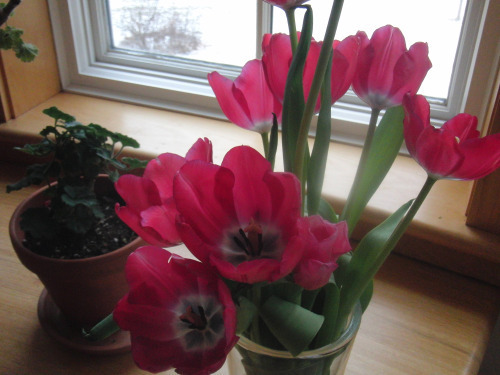Who’s the Judge?
Every red petal on the tulips remain, along with much of the snow in the yard, as I settle on the window seat for another day of writing. Last week I gave the first third of a verse novel about three different girls to my writing group. The second section is well underway, as I drafted the whole book before polishing a section enough to bring it to my friends, which I did without a sense of it being entirely done or quite close to wonderful. The section I’m working on now delights me with its smooth progress. I feel I know and love this girl. But I wonder if the poems are any better and accessible, a word I return to as a guide, along with the image: clear as water. I want flight, but the kind that young readers can follow. I feel I might be flying too high to follow in that first section. This middle section has the right weight, and is more like the lake I’m attempting. Maybe.
We can’t and shouldn’t get away from judgments: Does this line work? Will it make someone laugh or think? Is it even clear? But much should judgment be part of our actual writing? Learning when to let it into the process may take at least as much time as learning particulars about style and structure. We’re unwise to expect perfection-ish-ness from something that isn’t finished. For me, writing means accepting whatever comes my way first, evaluating later. Others write and assess one sentence or paragraph at a time. I have a high tolerance for mess, with high hopes for what it can turn into, and am happier writing a meandering draft that I’ll trim, polish, and send to my writing group for their gently but firmly told truths.
Can we circle from judgment back around to acceptance that we’re moving along the best we can, making a way between effort and complacency? Can we stretch and bend in every sentence? It’s yoga. Reach and concede or adjust. At last the thoughts of our first friendly readers and ourselves may bring us to a place where we believe our work is good enough for the eyes of people we may not know called editors. This sounds like it should be a step as simple as jumping over a fence, which maybe it is, but the fence is high and wide. We’re going to meet new judgments, which may revolve around how well the work succeeds at what it attempts, or instead raise issues beyond our words, such as the size of the potential audience, or slippery issues of taste.
Decades ago, I was lucky to learn that editorial judgments are a dangerous place to measure self-worth. In my work-study job at UMass, I wrote “Sorry” on small rejection notes for a literary magazine. That single hand-written word couldn’t show what happened in the basement office where intelligent people sometimes argued about a poem for twenty minutes. Someone laughed through one story. Wept at the end of another. Clattered coffee cups while piling them to wash in the bathroom and muttered, angry that a story didn’t make the cut. I learned that an editor’s response to a manuscript isn’t Fate’s or a reliable way for an author to decide whether or not a piece of writing is good. There was always more to the story than a rare “Yes” or the far more common, “Sorry.”
We’ve been trained through most of our lives to expect others to let us know when we’ve got something right, but that’s risky with creative work. Editors can be a lot of things, but they won’t necessarily be our final judge. We’ve got to learn to make our own assessments. Which seems to take a lifetime. But if I keep writing until the tulip petals fall, a few words will find their right places. That’s what I’m trying to trust.






